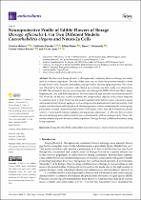Por favor, use este identificador para citar o enlazar este ítem:
https://repositorio.usj.es/handle/123456789/871
Registro completo de metadatos
| Campo DC | Valor | Lengua/Idioma |
|---|---|---|
| dc.contributor.author | Moliner Langa, Ana Cristina | - |
| dc.contributor.author | Casedas, Guillermo | - |
| dc.contributor.author | Barros, Lillian | - |
| dc.contributor.author | Finimundy, Tiane C. | - |
| dc.contributor.author | Gómez-Rincón, Carlota | - |
| dc.contributor.author | López Ramos, Víctor | - |
| dc.date.accessioned | 2022-12-05T11:34:56Z | - |
| dc.date.available | 2022-12-05T11:34:56Z | - |
| dc.date.issued | 2023-06-24 | - |
| dc.identifier.citation | Moliner, C.; Cásedas, G.; Barros, L.; Finimundy, T.C.; Gómez-Rincón, C.; López, V. Neuroprotective Profile of Edible Flowers of Borage (Borago officinalis L.) in Two Different Models: Caenorhabditis elegans and Neuro-2a Cells. Antioxidants 2022, 11, 1244. https://doi.org/10.3390/ antiox11071244 | en_US |
| dc.identifier.issn | 2076-3921 | en_US |
| dc.identifier.uri | https://repositorio.usj.es/handle/123456789/871 | - |
| dc.description.abstract | The flowers of Borago officinalis L. (Boraginaceae), commonly known as borage, are widely used as a culinary ingredient. The aim of this study was to assess the potential benefits of fresh borage flower extract related to antioxidant, neuroprotective and anti-aging properties. The extract was obtained by Soxhlet extraction with ethanol as a solvent, and fatty acids were detected by GC-FID. The antioxidant activity was evaluated in vitro through the DPPH, FRAP and ORAC assays. Regarding the fatty acid (FA) composition, the extract showed high amounts of polyunsaturated FA. The Neuro-2a cell line was used to determine the cytoprotective capacity of the extract subjected to oxidative stress (H2O2). Moreover, the model organism Caenorhabditis elegans was used to assess antioxidant activity, delayed ageing as well as cytoprotection and reduced _-amyloid toxicity. Cells treated with the extract and H2O2 showed a better response to oxidative stress than the control group, particularly in terms of mitochondrial activity (MTT assay), redox state (ROS formation) and the activity of antioxidant enzymes (catalase and superoxide dismutase). B. officinalis flower extract showed promising antioxidant activity in the selected models, without causing toxicity. Hence, the results obtained support the antioxidant properties of borage flowers in different bioassays using living organisms. | en_US |
| dc.format.extent | 14 p. | en_US |
| dc.format.mimetype | application/pdf | en_US |
| dc.language.iso | eng | en_US |
| dc.publisher | MDPI | en_US |
| dc.relation | The authors are grateful to the Foundation for Science and Technology (FCT, Portugal) for financial support from national funds FCT/MCTES, to CIMO (UIDB/AGR/00690/2020); for national funding by FCT, P.I., through the institutional scientific employment program contract for L. Barros contracts. Universidad San Jorge and Gobierno de Aragon are also thanked for their financial support (Phyto-Pharm Group B44_20D). | en_US |
| dc.rights | Atribución 4.0 Internacional | * |
| dc.rights.uri | http://creativecommons.org/licenses/by/4.0/ | * |
| dc.subject | Borago officinalis | en_US |
| dc.subject | PUFA | en_US |
| dc.subject | Antioxidant | en_US |
| dc.subject | Neuroprotection | en_US |
| dc.subject | C. elegans | en_US |
| dc.subject | Neuro-2a | en_US |
| dc.subject | Functional foods | en_US |
| dc.title | Neuroprotective Profile of Edible Flowers of Borage (Borago officinalis L.) in Two Different Models: Caenorhabditis elegans and Neuro-2a Cells | en_US |
| dc.type | info:eu-repo/semantics/article | en_US |
| dc.identifier.doi | https://doi.org/10.3390/antiox11071244 | en_US |
| dc.rights.accessrights | info:eu-repo/semantics/openAccess | en_US |
| Aparece en las colecciones: | Artículos de revistas | |
Ficheros en este ítem:
| Fichero | Descripción | Tamaño | Formato | |
|---|---|---|---|---|
| Neuroprotective Profile of Edible Flowers of Borage.pdf | 650,57 kB | Adobe PDF |  Visualizar/Abrir |
Este ítem está sujeto a una licencia Creative Commons Licencia Creative Commons

